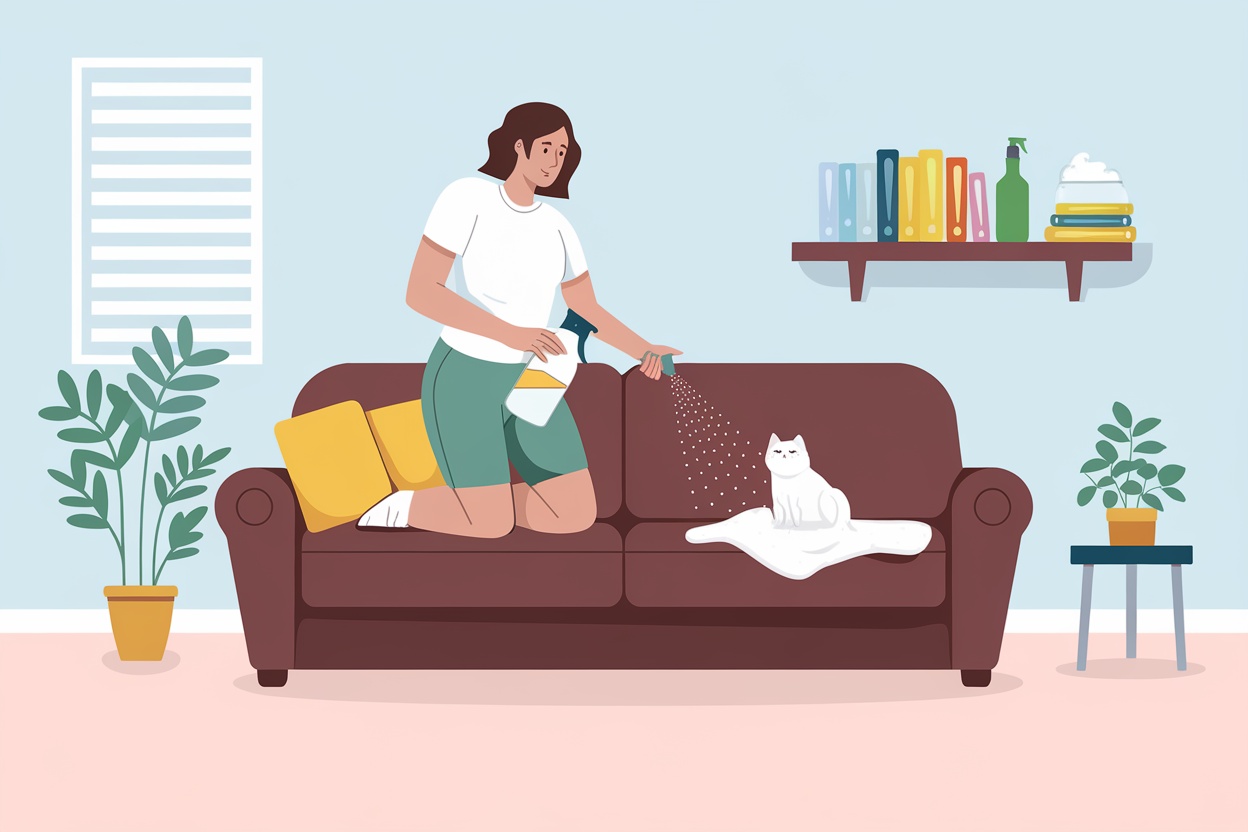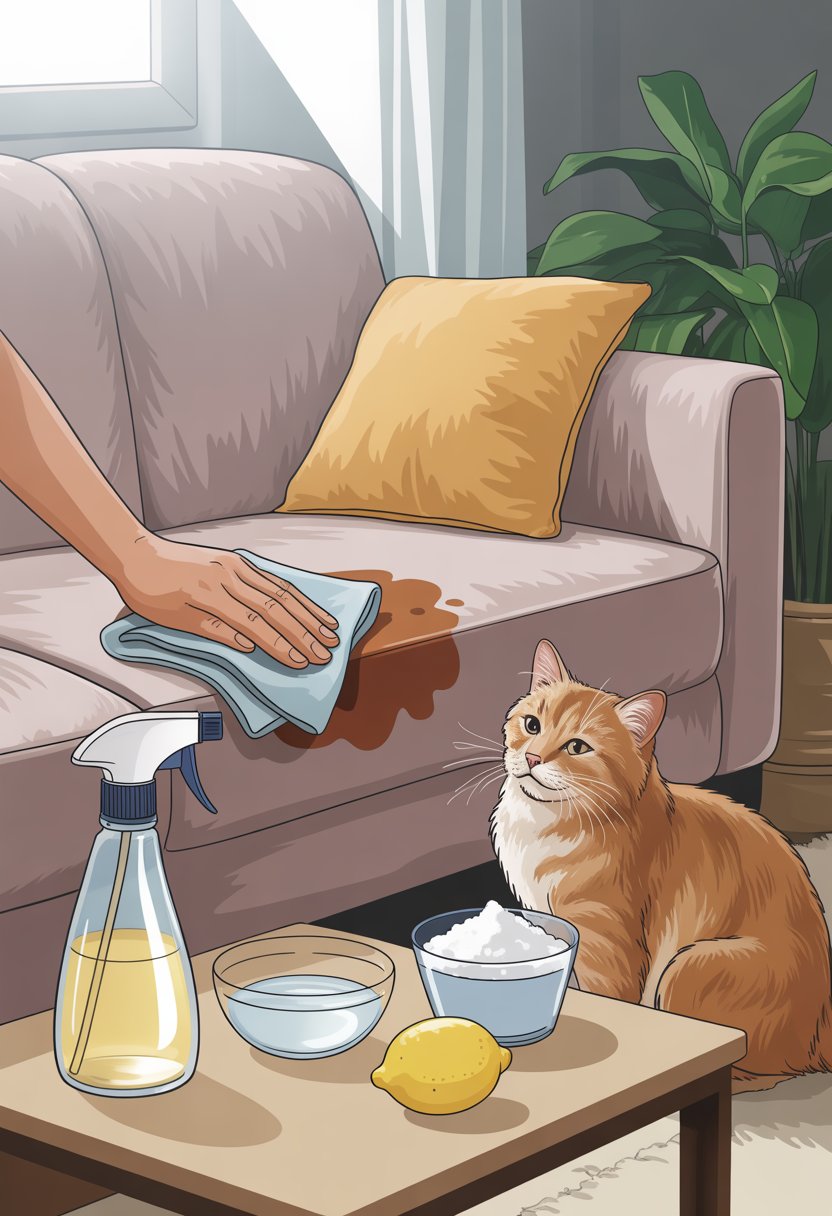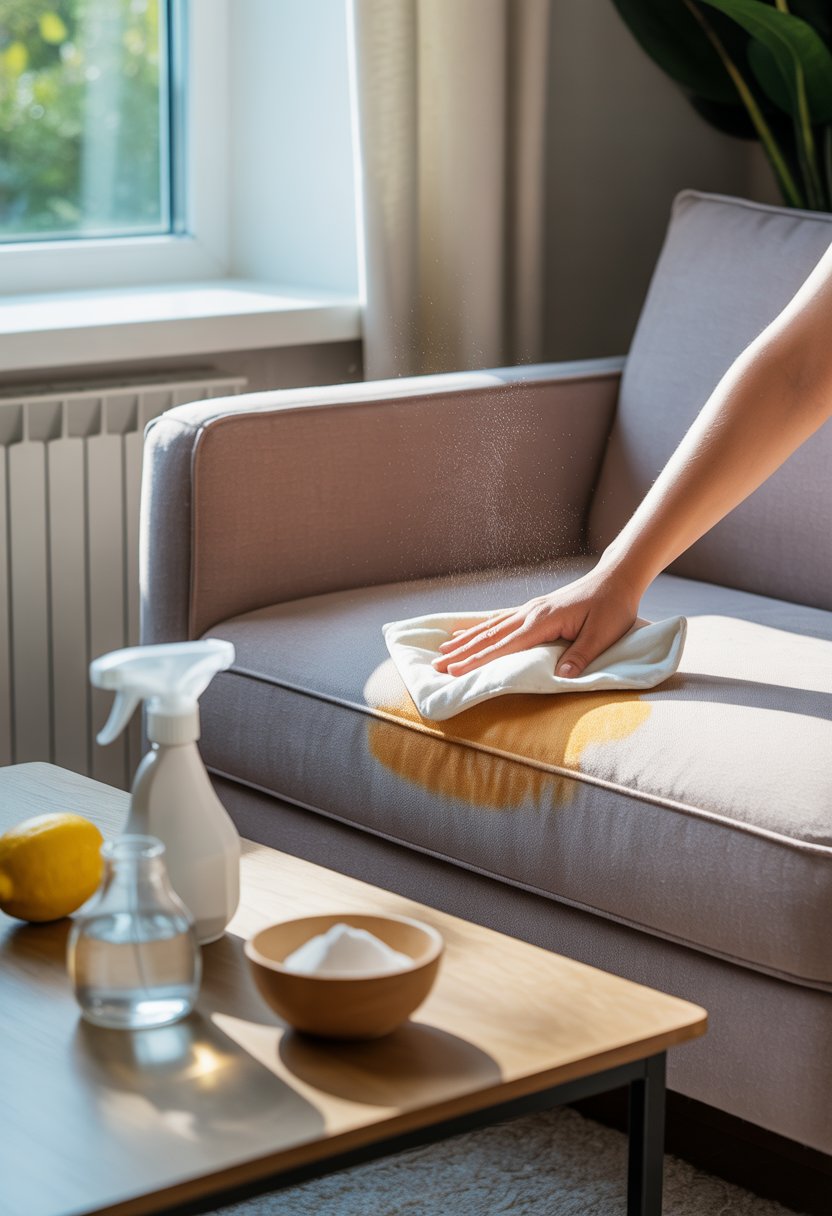
Cat pee smell on your couch can feel overwhelming, but you don’t need expensive cleaners to fix it.
You can completely remove cat urine odor from your couch using common household items like white vinegar, baking soda, and dish soap. These simple ingredients work together to break down the urine compounds that cause the smell.

Acting quickly matters, and the right method for your type of couch makes all the difference.
Different fabrics need different approaches, but the basic process is pretty similar.
This guide covers checking the damage, gathering supplies, and cleaning step by step.
You’ll also get tips for handling tough stains and stopping your cat from making the same mistake again.
Assessing Cat Pee Damage on Your Couch
When you find cat urine on your couch, knowing your couch material helps you choose the right cleaning method.
Different fabrics react differently, so you want to avoid making things worse.
Identifying Affected Areas
Use your nose first to hunt down the strongest odor. Cat pee has that unmistakable ammonia punch, and it gets sharper as you get closer.
Look for visible stains. Fresh urine leaves wet spots, pretty easy to spot. Older stains might show up as yellow or brown marks, especially on light-colored couches.
Grab a blacklight flashlight if you have one. Cat urine glows under UV light, so you can spot dried stains that aren’t obvious. Just turn off the room lights and scan slowly.
Pay close attention to:
- Cushion corners and edges
- Arm rests (cats love these)
- Back cushions against the wall
- Under removable cushions
Feel the fabric. Dried urine often makes it feel stiff or crusty. Sometimes it’s still a bit damp if the urine soaked deep.
Understanding Different Upholstery Types
Leather couches are usually the easiest to clean. Urine tends to sit on the surface instead of soaking in. Still, harsh cleaners can crack leather, so be careful.
Fabric couches absorb urine fast. The liquid seeps into the cushion filling, which makes the smell tough to get out. Cotton and linen hold onto odors more than synthetics.
Microfiber couches are a bit more forgiving. The tight weave keeps some urine out, but if it gets in, the smell can still stick around.
Check the couch tag for cleaning codes:
- W: Water-based cleaners only
- S: Solvent-based cleaners only
- WS: Either water or solvent cleaners
- X: Vacuum only (might need a pro)
Removable cushion covers are a blessing. If the care label says it’s okay, toss them in the washing machine.
Essential Home Ingredients for Cat Pee Odor Removal
You can kick that cat pee smell using three things you probably already have at home.
White vinegar and baking soda neutralize odors. Hydrogen peroxide breaks down urine crystals, and dish soap lifts stains out of the fibers.
Vinegar and Baking Soda
White vinegar is a natural deodorizer and it tackles the ammonia in cat urine. The acid in vinegar helps break down those nasty-smelling compounds.
Mix equal parts white vinegar and water in a spray bottle. Spray the solution right onto the smelly spot.
Let it sit for 10-15 minutes. The vinegar smell will fade (promise), and it takes the urine odor with it.
Next, sprinkle baking soda over the damp area. Baking soda soaks up leftover moisture and odors.
Heads up: Don’t mix vinegar and baking soda in the same bottle. Use them one after the other for best results.
Let the baking soda chill on your couch for 2-4 hours, or overnight if you can. Afterward, vacuum it up with your upholstery attachment.
Hydrogen Peroxide
Hydrogen peroxide goes after uric acid crystals—the real stink culprits. Grab 3% hydrogen peroxide (the regular kind from the store).
Test it on a hidden spot first. It can bleach fabrics, especially darker ones.
Pour hydrogen peroxide right on the stained area. If you see a little bubbling, that means it’s working.
Give it 30 minutes to do its thing. Then blot up the excess liquid with paper towels.
Warning: Only use 3% hydrogen peroxide. Stronger stuff can wreck your fabric and isn’t safe.
Crack a window or turn on a fan when you use it. Good airflow helps.
Dish Soap
Dish soap helps lift urine stains from fabric and boosts the power of the other cleaners. Stick to clear or white dish soap—no dyes or perfumes.
Mix 1 tablespoon of dish soap with 2 cups of warm water. Stir gently so you don’t get too many bubbles.
Apply the soapy water with a clean cloth, working from the outside in.
Rinse with clean water to get rid of soap residue. Soap left behind can attract dirt and make your couch look grungy.
Blot dry with towels, pressing firmly to get as much moisture out as you can.
Step-by-Step Cleaning Process
Here’s how I tackle it: first, get rid of wet urine, then use an acid solution to break down the odor, and finally, let baking soda soak up what’s left.
Blotting and Preparing the Area
Blot up any wet urine with paper towels or clean rags. Press down, but don’t rub—rubbing just pushes the pee deeper.
Take off couch cushions if you can. If the covers come off and the label says it’s safe, throw them in the wash on cold with regular detergent.
What you’ll need:
- Paper towels or rags
- Vacuum cleaner
- Spray bottle
- Rubber gloves
Mark the spot with your finger so you don’t lose track of it. Urine can spread further than it looks.
Vacuum the area to clear away any debris or pet hair. This lets your cleaning solutions work better.
Applying Vinegar Solution
Mix one part white vinegar and one part water in your spray bottle. This combo breaks down the acids in cat pee that make it reek.
Spray the mixture on the stain, covering the area and about two inches around it. Wait 5-10 minutes.
Don’t forget:
- Only use white vinegar
- Don’t drown the fabric
- Keep a window open if you can
Blot again with clean towels to soak up the vinegar and any leftover urine. The vinegar smell won’t last.
Using Baking Soda for Odor Absorption
Sprinkle a thick layer of baking soda over the treated area.
Give it at least 4 hours, or overnight if you’re dealing with a stubborn smell.
Vacuum up all the powder. Go over it a couple times to make sure you get it all.
Take a sniff once it’s dry. If you still smell pee, just repeat the process.
Deep Cleaning for Persistent Odors
Sometimes, basic cleaning just isn’t enough. Hydrogen peroxide can break down those stubborn uric acid crystals, and homemade enzyme cleaners use natural bacteria to eat away at odor-causing compounds.
Hydrogen Peroxide Method
Mix 1 cup of 3% hydrogen peroxide with 1 teaspoon of dish soap and 1 tablespoon of baking soda. It’ll turn into a paste.
Test it on a hidden spot first—hydrogen peroxide can lighten some fabrics.
Rub the mixture onto the stain with a clean cloth, using little circles.
Let it sit for 10-15 minutes. You’ll probably see some foaming as it works.
Blot with clean towels, then rinse with cold water and blot again until the soap’s gone.
Set up a fan to dry the area faster. That helps prevent mold.
Enzyme Cleaner Alternatives
You can make your own enzyme cleaner with brown sugar, citrus peels, and water. Mix 1 cup brown sugar and peels from 3 oranges or lemons.
Add 4 cups of water, pour it into a plastic bottle, and let it ferment for about 3 months.
Shake it daily for the first week. It’ll grow bacteria that munch on urine compounds.
Once it’s ready, pour it generously over the stain and let it sit for 30 minutes before blotting.
If you’re in a pinch, white vinegar and water (equal parts) in a spray bottle works too.
Drying and Ventilating Your Couch

After you clean up the cat pee, drying your couch properly is essential. Otherwise, the smell can come back or, worse, you could end up with mold.
Good airflow and moisture control are key.
Proper Air Circulation Techniques
Open all the windows and doors to get a cross-breeze going.
Place fans around your couch—one blowing straight at the wet spot, another across the room pulling air away.
Fan tips:
- Point them at different angles to cover everything
- Multiple small fans beat one big one
- Keep them running for at least 6-8 hours
Take off the cushions if you can. Stand them up against the wall with gaps between them so air gets everywhere.
Turn on your AC or heat if you need to. Cool, dry air beats warm, humid air for drying.
Preventing Mold and Mildew
Check your couch every few hours while it’s drying. Watch out for dark spots or musty smells.
Keep an eye out for:
- Black or green spots
- Musty odor
- Still damp after 8+ hours
If you live somewhere humid, run a dehumidifier and keep the room below 50% humidity.
Don’t use a hair dryer or space heater directly on the fabric. High heat can bake the odor in for good.
If it’s still damp after half a day, sprinkle baking soda on the wet spots. Wait a couple hours, then vacuum it up. Baking soda helps soak up extra moisture.
Preventing Future Cat Pee Incidents
If you want to keep your couch safe, you’ve got to fix the root issue. Most accidents happen because of litter box problems, stress, or sometimes medical stuff that needs a vet’s attention.
Addressing Cat Behavior
Check the litter box first. Cats really don’t like dirty boxes, so scoop out waste every day. Change the litter about once a week.
Place one box per cat, plus an extra, and spread them out in different spots around your place.
Use the right litter depth. Aim for about 2-3 inches of litter in each box. If you go overboard or skimp, cats might not be happy with it.
Watch for stress signs. Moving, adding new pets, or even shifting your routine can throw your cat off. When things get chaotic, try offering quiet corners or familiar blankets to help them chill out.
Schedule a vet visit. Sometimes, cats avoid the box because they’re hurting—think urinary infections, kidney stuff, or even arthritis. A quick checkup can catch these problems before they turn into habits.
Clean accidents completely. If your cat has an accident, grab an enzyme cleaner and really get in there. Otherwise, that lingering smell will just keep drawing them back.
Maintaining a Clean Couch Environment
Cover your couch when away. Toss on plastic covers, aluminum foil, or furniture protectors. Cats usually hate those textures, so they’ll steer clear.
Remove scent triggers. Grab the vacuum and go over couch cushions every week to tackle pet hair and dander. Once a month, toss removable covers in the wash with enzyme detergent—it’s a bit of a chore, but it helps.
Block couch access. Set storage bins or extra furniture around the couch base. That way, cats can’t slip underneath or hop up as easily.
Use safe deterrents. Try spraying citrus-scented cleaners on the couch. Most cats turn up their noses at citrus, but it won’t bother you or your guests.
Create better alternatives. Put scratching posts and cat beds right by the couch. If you give your cat cozier spots, they just might pick those over your furniture—worth a shot, right?

